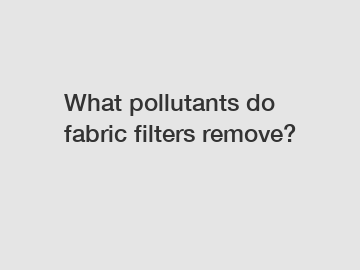What pollutants do fabric filters remove?
Have you ever wondered what pollutants fabric filters remove from the air around us? Well, wonder no more! In this article, we will explore the types of pollutants that fabric filters target and how they work to keep our air clean and safe for all to breathe.
What are fabric filters?
Fabric filters, also known as baghouses, are air pollution control devices used to remove particulate matter from industrial emissions. They are commonly used in industries such as cement manufacturing, power generation, and chemical processing to trap harmful pollutants before they are released into the atmosphere.

1. Particulate Matter.
One of the main pollutants that fabric filters remove from the air is particulate matter. These tiny particles can come from a variety of sources, including dust, smoke, and exhaust emissions. Fabric filters are designed to capture these particles as they pass through the filtering medium, preventing them from being released into the air.
2. Heavy Metals.
Fabric filters are also effective at removing heavy metals from industrial emissions. These toxic substances, such as lead, mercury, and cadmium, can have serious health implications if released into the environment. By trapping these metals in the filter media, fabric filters help prevent them from contaminating the air and surrounding areas.
3. Acid Gases.
Acid gases, such as sulfur dioxide and hydrogen chloride, are another type of pollutant that fabric filters can remove from industrial emissions. These acidic compounds are a byproduct of certain industrial processes and can contribute to air pollution and acid rain. Fabric filters capture these gases and prevent them from being released into the atmosphere.
How do fabric filters work?
Fabric filters work by using a series of bags or cartridges made of woven or felted fabric to capture particulate matter as it flows through the filtering medium. As the polluted air passes through the fabric, the particles are trapped on the surface or within the fibers of the filter, leaving behind clean air to be released into the environment.
The fabric filter bags are cleaned periodically to remove the accumulated particles, allowing the filter to continue operating at peak efficiency. This cleaning process can be done using a variety of methods, such as shaking, pulsing, or reverse-air flow, depending on the specific design of the fabric filter.
In conclusion, fabric filters play a crucial role in removing pollutants from industrial emissions and helping to protect the air we breathe. By targeting particulate matter, heavy metals, and acid gases, these devices help to improve air quality and reduce the environmental impact of industrial activities. If you have any questions about fabric filters or would like to learn more about how they can benefit your business, feel free to contact us today. Our team of experts can help you find the right fabric filter supplier for your specific needs.
Are you interested in learning more about fiberglass filter manufacturer, Molten Metal Filtration, ceramic filter plate? Contact us today to secure an expert consultation!
219
0
0

Comments
All Comments (0)